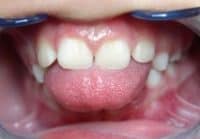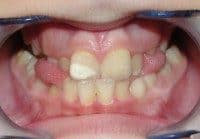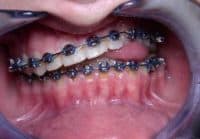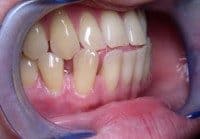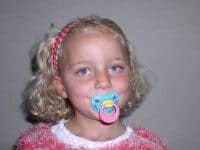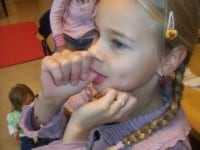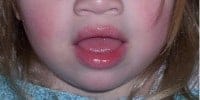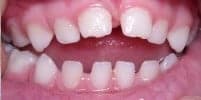Remedial therapy based on restoring the balance of the oral muscles.
Myofunctional therapy is a remedial therapy based on the recovery of the imbalance in the functioning of the oral muscles. In general, abnormal oral habits cause an imbalance between the oro-facial muscles. This imbalance can lead to an abnormal physiognomy and morphology.
For example, dysfunctional oral habits like mouth breathing, thumb sucking, etc. in combination with an abnormal swallowing habit can lead to a strong protrusion of the upper front. The tongue thrusts the front buccal elements forward. The lips, which are not closed in case of mouth breathing, do not exert any counter pressure.
In this case, the incorrect use of the muscles and the absence of counter-pressure will lead to an abnormal shape of the jaws and/or teeth. The functional malocclusion is a fact. If it has to be changed, it is obvious that the function of the muscles involved should be changed first.
A multidisciplinary approach is therefore desirable for a lasting result. Dentists and orthodontists deal with the shape and morphological abnormalities of the teeth and speech therapists deal with the function of the oro-facial muscles.
Speech therapist play an important role in muscle recovery
Dentists and orthodontists who are often involved in the treatment of children are responsible for recognising the relation between dysfunctional muscle patterns and abnormal morphology or occlusion. They are also responsible for restoring the balance in the muscle function prior to any intervention.
In the Netherlands a referral to a speech therapist is then indicated (Guideline: mondzorg voor Jeugdigen, NMT). The speech therapist plays an important role in restoring the imbalance in the functioning of the muscles of the oro-facial skeleton. Speech therapy relates to the functional aspects of the dysfunctional oral habits (thumb-, finger-, pacifier sucking, mouth breathing, abnormal swallowing pattern, abnormal rest position of the tongue, tongue thrust, abnormal chewing patterns). Sometimes this will also cause the speech to be abnormal.
The speech therapist will use objective measuring instruments like: the forcescale (for measuring lip strength), the Payne technique (visualisation of the swallowing pattern trough fluorescence technique) and the myo-scanner (an instrument to measure lip, tongue and masticatory muscles). Early recognition and treatment of abnormal oral habits and abnormal swallowing patterns are of great importance for a stable occlusion.
Tailor-made OMFT
If you work in a practice or institution and you regularly have questions about OMFT therapy, certain cases that are difficult, etc., it is possible to arrange OMFT tailor-made. In consultation I come to your practice or institution for a half day and together we treat a number of patients and evaluate the cases. This can also be in the field of setting up a multidisciplinary collaboration.
In general we can say that dysfunctional oral habits can cause many dental, orthodontic and speech abnormalities. These include abnormal swallowing patterns, mouth breathing, thumb-, finger-, and pacifier sucking or nail biting. The early recognition and unlearning of this aberrant behaviour can save a lot of trouble later on.
Abnormal Swallowing patterns
An abnormal function of the tongue greatly impacts the grinding of the food, formation of a foodchunk (bolus?) and the act of swallowing. Abnormal swallowing patterns are usually accompanied by tongue thrusts, forward or sideways. This almost always affects the position of the teeth and the shape of the jaw: an open bite will form where the tongue leaves the mouth and the teeth cannot touch:
- In the case of lisping, the tongue is partially or completely pressed between the front teeth; the front teeth won’t close fully.
- In the case of ‘slissen’, the tongue produces the alveolar sounds sideways (near the premolars); this will cause an bilateral open bite.
These open bites can be closed with orthodontic treatment, and the teeth will nicely line up again. However, in most cases (26-38% prevalence) the open bite will reappear, because the initial cause of the open bite, in these cases a wrong tongue position, hasn’t been treated.
Thumb-, finger-, or pacifier sucking and nail-biting
It is common knowledge that frequently sucking on thumbs or fingers leads to an abnormal position of teeth and/or jaws. This also applies to tongue- and lip-sucking, or sucking too long/nibbling too intense on a pacifier. Biting habits (e.g. finger, nail or lip biting, or clamping & grinding teeth, etc.) can have a detrimental effect on the jaw joint, overloading the muscles. Other muscle groups in the mouth may also be adversely affected.
Mouth breathing
The function of the nose includes humidifying, heating and cleaning the inhaled air. This beneficial property is lost in case of mouth breathing. This can result in recurrent infections of the throat, tonsils or (frequently) recurring middle ear infections. We often see the front teeth moving forward, as a result of the loss of pressure from the lips on the teeth. A narrow palate also occurs and to a greater or lesser extent drooling.
Approach
Various anomalies can cause an imbalance between the mouth muscles (lips, chewing muscles, tongue and tongue muscles). The shape of the jaws (and the position of the teeth) will adapt to this imbalance. In other words: the (in this case wrong) function of the muscles gives a (in this case wrong) shape of the jaws. So if we want to change the shape of the jaws, we will have to start changing the function of the muscle groups involved. This is called oro-myofunctional therapy.

